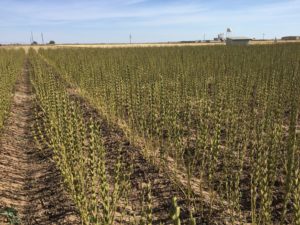Submitted by
Dr. Calvin Trostle, Extension Agronomy, TAMU Dept. of Soil & Crop Sciences, Lubbock, 806-746-6101, ctrostle@ag.tamu.edu
May 8, 2019
Sesame is a drought tolerant, heat tolerant crop that has a relatively low number of pests—either insects or plant diseases—compared to other Texas crops. Sesaco Corp. (http://www.sesaco.com) has offered Texas growers indehiscent (non-shattering) sesame for over 15 years. Compared to then today’s sesame varieties are a slightly shorter in maturity. Non-shattering varieties enable combine harvest. Though they are called non-shattering, some losses do occur. This is in sharp contrast to sesame in other world regions where much sesame is harvested by hand (“shocked”). This keeps the plants standing upright to avoid seed losses from the capsule. Despite that harvest method in most of the world, sesame is the #4 oilseed crop in world production.
Fig. 1. A recent Sesaco sesame field near Lubbock on 40” rows and furrow irrigation.
Sesaco’s contact’s include Jerry Riney in Central Texas, M 806.778.2193, jriney@sesaco.com, and Joe Guzman, High Plains & Rolling Plains, M 806.781.5908, jguzman@sesaco.com . Contact either staff for information on Sesaco production contracts for 2019. Sesame is one of the few crops where prices for 2019 have increased from last year. Sesaco is recently quoting $0.40/lb. with potential for premiums based on clean grain, low trash, low cracks, etc.
A Second Company Now in the Texas Sesame Market
Equi-nom is a breeding and genetics company based in Israel. They have tested their non-shattering genetics in Texas since 2017 for both commercial varieties and breeding nurseries in the Lubbock and Uvalde areas. Limited commercial production occurred in 2018 in the Texas High Plains. Texas A&M AgriLife does not yet have data to compare yields of Equi-nom and Sesaco lines. Field observations of Equi-nom lines show that individual nodes on the stalk often produce two and even three flowers hence capsules per node, instead of one. So, the yield potential looks promising.
Fig. 2. Multiple capsules per node of a commercial Equi-nom sesame variety, 2018, Lubbock.
Depending on the location in Texas, Equi-nom has partnered with contractors and elevators for crop purchase and delivery. Garcia Grain in the Lower Rio Grande Valley will receive about 13,000 acres of production for export to Mexico. Further acreage to meet demand to supply an international company as well as additional Garcia Grain acres are offered in the Rolling Plains and High Plains. Statewide producer contact for Equi-nom is Erin Sim, M 806.231.6517, erins@equi-nom.com.
Sesame and Wild Hogs & Crop Insurance
Numerous individuals including farmers, Sesaco staff, and former Texas A&M AgriLife Extension agronomists Mr. Charles Stichler (Uvalde) and Dr. David Drake (San Angelo) note that wild hogs do not appear to cause major issues with sesame stands and harvest. Wild hogs may be in the field, but damage is low. Wild hogs are not an issue to avoid sesame. That is an important consideration as is crop insurance.
Sesaco staff also helped successfully carry the appeal to USDA’s Risk Management Agency for crop insurance for sesame. Currently there are 90 counties in Texas and southwest Oklahoma where crop insurance is directly available. Farmers in other counties can apply for sesame crop insurance under a written agreement.
Some Sesame Basics
Here are some key considerations for sesame production in Texas.
• Sesame is not for your weedy ground. There are labels for yellow herbicides (Treflan, Sonalan, Prowl) and grasses after emergence. There is an “indemnified” label from Syngenta for use of Dual Magnum (s-metolachlor) where the farmer agrees to accept all risk (rates are lower than other crops). Starting clean is important as sesame is not competitive with weeds for the first five weeks or so after emergence.
• Growers report that sesame is sensitive to glyphosate and 2,4-D drift and especially to dicamba.
• Nitrogen fertility should not be neglected for a sesame crop.
• Sesame is suitable for dryland production in Texas in lower rainfall areas like the High Plains, Rolling Plains, Concho Valley, and Lower Rio Grande Valley. When irrigated modest amounts of irrigation up to 8” can be an economic ‘sweet spot’ for production.
• Sesame is harvested with conventional headers and grain combines. Plan on some time to help get your settings optimized and learn how to best get the crop fed onto the header. Sesaco has long aided growers in getting combines set properly.
For further information see the Texas A&M AgriLife sesame primer online at http://lubbock.tamu.edu/sesame and consult with your contractor.
Dr. Calvin Trostle, Extension Agronomy,
TAMU Dept. of Soil & Crop Sciences, Lubbock,
806-746-6101, ctrostle@ag.tamu.edu


